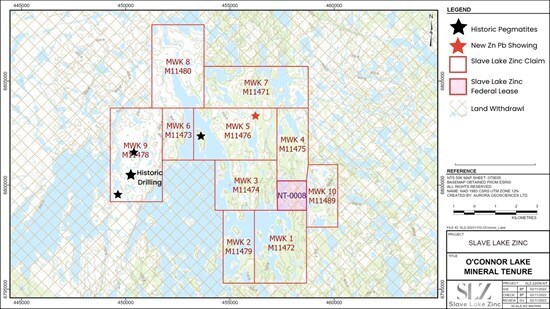Vancouver, British Columbia--(Newsfile Corp. - February 21, 2023) - Slave Lake Zinc Corp. (CSE: SLZ) (the "Company"): has reviewed historic drill logs recently obtained for 13 drill holes reported by American Yellowknife Mines from drilling conducted in 1951 at the MCO targets on the west side of O'Connor Lake. Slave Lake has noted that pegmatites and pegmatitic granites have been documented in these holes. Pegmatites were reported and ranged from less than 1 meter to over 10 meters in drill section. Exploration in 1951 was designed to test for zinc-lead-copper mineralization at O'Connor Lake. There was no evaluation for lithium or tantalum-columbite mineralization which are now a necessity for electrification (green energy).
The historic drilling occurred approximately 7 kilometers west of the Company's original Shaft Zone deposit. Major structures comprising high-grade zinc-lead mineralization, similar to those at the O'Connor Lake Saft Zone, were discovered west of O'Connor Lake prior to 1950 and were the target of the early MCO drilling. The 1951 drilling tested two separate vein systems in a series of widely-spaced holes ranging in depths of less than 90 meters. Recorded drill results include multiple vein intersections of pegmatite ranging from less than 1 meter to over 7 meters. No assay data is available to the Company from this drilling. This is a new area in which to focus exploration using geological mapping, sampling, and ground geophysical surveys to target drilling pegmatites and verify the historic intercepts of zinc-lead mineralization.
The company is looking to establish a resource at the O'Connor Lake project and can achieve this by a confirmation drill program of the historic intercepts as well as targeting additional areas for zinc-lead mineralization. As part of this program, the lithium potential of the known pegmatites will also be evaluated.
Figure 1 Click Image to enlarge.
To view an enhanced version of Figure 1, please visit:
https://images.newsfilecorp.com/files/6453/155501_b85c1676b418b83a_001full.jpg
The country host rocks in the MCO area are comprised of a multiple-phased granitic intrusive complex which intrudes older regional metamorphic rocks. Sills and dykes of pegmatite cut the older metasedimentary units and earlier stage intrusives. The pegmatites are closely associated with the youngest intrusive, a muscovite granite, as structural continuations and in composition. The area where the 1951 drilling was undertaken has a series of major deep-seated structures along which the multiple-stage dyke swarms were able to intrude during the final phases of intrusive activity. Very late-stage hydrothermal systems were also able to intrude and deposit in the same fracture systems as veins and stockworks. This style of hydrothermal zinc-lead-copper deposition is the same as observed nearby at the Company's known occurrences.
Ritch Wigham, CEO, commented, "It can not be overstated how the historic data has enhanced our ability to advance this project in comparison to our peers. Lithium exploration will be substantially advanced with the recognition of pegmatites within the historic drilling. With the historic data now at hand, Slave Lake can better focus our exploration efforts and define drill targets more efficiently. Our focus initially was the high-grade zinc-lead+/- copper mineralization, but we can now add lithium as a target metal at our O'Connor Lake critical metals exploration project."
QP Gary statement: This release and its contents have been reviewed and approved by Gary Vivian, M.Sc., P.Geol a Qualified Person under NI 43-101.
About Slave Lake Zinc
Slave Lake Zinc Corp. intends to develop the potential of its O'Connor Lake property, a historic zinc-lead +/- copper geologic resource, located in the Northwest Territories of Canada. The property is located south of Great Slave Lake and to the east of the Pine Point project. The property was initially developed after the Second World War and subsequently abandoned in 1952 when zinc and lead prices collapsed post-war. Slave Lake Zinc Corp. believes that it is well positioned to advance this project and to expand significantly the historic potential of the property. For more information, please visit www.zinccorp.ca.
On Behalf of the Board of Directors,
Slave Lake Zinc Corp.
Per:
Ritch Wigham CEO & Director
Phone: 604-396-5762
Email: [email protected]
Neither the Canadian Securities Exchange nor its regulation services provider has reviewed or accepted responsibility for the adequacy or accuracy of the content of this news release.
Forward-Looking Statement
Statements in this news release that are forward-looking statements are subject to various risks and uncertainties concerning the specific factors disclosed here and elsewhere in both Slave Lake Zinc's periodic filings with Canadian securities regulators. When used in this news release, words such as "will", "plan", "estimate", "expect", "intend", "potential", "should," and similar expressions, are forward-looking statements. Information provided in this document is necessarily summarized and may not contain all available material information. Forward-looking statements include, without limitation, statements regarding the progress of a definitive offtake agreement, potential development and production at the Company's O'Connor Lake project, future oriented events and other statements that are not facts. Forward-looking statements are based on a few assumptions and estimates that, while considered reasonable by management based on the business and markets in which Slave Lake Zinc operates, are inherently subject to significant operational, economic, and competitive uncertainties and contingencies. Such forward-looking statements should therefore be construed in light of such factors. Although Slave Lake Zinc has attempted to identify important factors that could cause actual results, performance, or achievements to differ materially from those contained in the forward-looking statements, there can be other factors that cause results, performance or achievements not to be as anticipated, estimated or intended. There can be no assurance that such information will prove to be accurate or that management's expectations or estimates of future developments, circumstances or results will materialize. Accordingly, readers should not place undue reliance on forward-looking statements. The forward-looking statements in this news release are made as of the date of this news release, and Slave Lake Zinc disclaims any intention or obligation to update or revise such information, except as required by applicable law, and Slave Lake Zinc does not assume any liability for disclosure relating to any other company herein.

To view the source version of this press release, please visit https://www.newsfilecorp.com/release/155501








